(This is the second part of a mammoth essay by our Russian contributor Comrade Aleks, who explores a variety of spiritual rituals and their connections to doom metal. Part One is here.)
Tonight we’re finishing our brief research of Dark Rituals performed by doom bands all over the world. In the first part of this article we took part in Voodoo and Aghori rituals with Pombagira and The Moon Mistress, we participated in Christian and Black Mass ceremonies with Griftegard and Hour of 13, and besides that we even visited the Sabbath in some godforsaken pub alongside Barabbas, we summoned Cthulhu with Arkham Witch, and spent the Beltaine feast with Serpent Warning and the Wakan Tanka ritual with Caronte. Is it too much? Not at all. I have a few more examples of how sacred, ancient, esoteric traditions of dark occult wisdom have been reflected in the music of modern doom bands.
Today Reino Ermitano, War Injun, Ethereal Riffian, Tenochtitlan, Alunah, Stangala, Matus, Obake, Taak, and the almighty Abysmal Grief lead us into the mystic realms of the unknown. And I must warn you once more – don’t even try to perform these mysteries at home!
Peruvian Shamanic Ritual with Reino Ermitaño
Shamanic traditions of Peru and other regions alongside the Amazon river are known because of the ritualistic use of the hallucinogenic plant ayahuasca. Ayahuasca is a psychedelic brew made out of the Banisteriopsis caapi vine, often in combination with various other plants. It can be mixed with the leaves of Chacruna or Chacropanga, dimethyltryptamine (DMT)-containing plant species.
The brew was first described academically in the early 1950s by Harvard ethnobotanist Richard Evans Schultes, who found it employed for divinatory and healing purposes by the native peoples of Amazonian Peru. It has been reported that some effects can be felt from consuming the caapi vine alone, but that DMT-containing plants (such as Psychotria) remain inactive when drunk as a brew without a source of monoamine oxidase inhibitor (MAOI) such as Banisteriopsis caapi. It is unclear how indigenous peoples discovered the hallucinogenic properties of the plants used in the ayahuasca brew. Many indigenous Amazonian people say they received the instructions directly from plants and plant spirits.
Some shamans and experienced users of ayahuasca advise against consuming ayahuasca when not in the presence of one or several well-trained shamans. In some areas there are purported brujos who masquerade as real shamans and who entice tourists to drink ayahuasca in their presence. Shamans believe one of the purposes for this is to steal one’s energy and/or power, of which they believe every person has a stockpile.
I have no personal knowledge or right to promote the ayahuasca brew, but I know a band whose members have shared their experience of it through their music. It’s the Peruvian traditional doom band Reino Ermitaño. When I asked Tania Duarte, vocalist of Reino Ermitaño, what she knows about it, I received this comment:
“This is ancient chamanic indian knowledge from the Amazonian jungle where the vine is found. The potion obtained from this plant, previously boiled with another one (chacruna) acting as a catalyzer, leads you to body, mind, and spiritual healing, answers, creativity, and magic. Hallucinations of color and geometry accompany the process of inner and outer cleansing and change.
“It´s a trascendental experience for everyone and especially artists. Doors of perception are opened, demons are expelled, colors surround you. The whistling and chanting of sacred melodies by the chaman throughout the whole night ritual embrace you in a life-changing experience. This is knowledge that has been despised by occidental culture, but in these so-called primitive rituals lies an answer to internal and external harmony in my personal opinion…
“I believe the visions and ideas you receive during these trances plus the changes you undergo at a personal level are definitely manifested in your art, lyrics, and music. In my case, I have reconnected with what was always my calling: the protection of nature and an ancient culture’s wisdom. The acceptance of a dark, animal side or shadow within, that is a rich part of our spiritual self and people are most generally trying to hide or disguise it with terrible consequences to society. I´ve become more politically aware and empathetic with social causes than I was in the past. A new sense of creativity and new universes have opened to me and some ideas shine with clarity and now have a solid shape”.
(original text: http://www.doommantia.com/2011/01/reino-ermitano-we-are-witch-doom.html)
I’ve chosen the song “El mi Mente” from Reino Ermitaño’s new album Conjuros de Poder (released by Ogre Records in 2014) as an illustration for the ayahuasca ritual. And Julio Almeida (drums) shared with me his story about the song:
“I wouldn’t say it was ‘composed’, but something that came to me during an ayahuasca ritual. The melody presented itself as a constant riff, without changes, a heavy mantra that deserved to be a song. In that moment everything was pure and spiritual. I kept it gratefully in my mind and days later wrote the lyrics“.
(original text: https://www.nocleansinging.com/2015/04/22/an-ncs-interview-reino-ermitano/)
Some necessary elements: experienced shaman, ayahuasca brew, diet, and clear mind.
You can perform the ritual in the Amazonian jungles of Peru.
Consequences: purification of body, mind, and soul; finding answers to important questions; getting the experience of unity with Nature.
Side effect: bad brujos can steal your energy.
Reino Ermitano – En mi mente
Ghost Dance with War Injun
Now let’s continue studying shamanic traditions and move from South to North America… and the experience of Native Americans. The Ghost Dance was a religious movement incorporated into numerous Native American belief systems. According to the teachings of the Northern Paiute spiritual leader Wovoka (renamed Jack Wilson), proper practice of the dance would reunite the living with spirits of the dead and bring peace, prosperity, and unity to native peoples throughout the region.
The basis for the Ghost Dance, the circle dance, is a traditional ritual that has been used by many Native Americans since prehistoric times, but this new form was first practiced among the Nevada Paiute in 1889. The practice swept throughout much of the Western United States, quickly reaching areas of California and Oklahoma. As the Ghost Dance spread from its original source, Native American tribes synthesized selective aspects of the ritual with their own beliefs.
The Ghost Dance was associated with Wilson’s (Wovoka’s) prophecy of a peaceful end to white expansion while preaching goals of clean living, an honest life, and cross-cultural cooperation by Native Americans. Practice of the Ghost Dance movement was believed to have contributed to Lakota resistance to assimilation under the Dawes Act. In the Wounded Knee Massacre in 1890, U.S. Army forces killed at least 153 Miniconjou and Hunkpapa from the Lakota people. The Sioux variation on the Ghost Dance tended towards millenarianism, an innovation that distinguished the Sioux interpretation from Jack Wilson’s original teachings. The Caddo Nation still practices the Ghost Dance today, for example.
And indeed, not only the Caddo Nation… Do you know the doom band War Injun from Maryland? There’s a song named “Ghost Dance” in their album Tribal Eulogy (2010) and it is absolutely fitting for our topic. JD Williams chants his deciphered invocations alongside monolithic riffs and under the rhythmic pounding of tribal drums:
“A gift to own, was not the field mountain desert plan
“So on three moon roam, left three boys to return a man.
“And on the southern rid, share eyed and gallop proud
“They saw the silver lone wolf that would lead them through the clouds northern clouds”.
JD – as vocalist and lyricist – says: “After reading the many different versions of spirit and vision quests where tribes would send the young soon to be hunters and warriors off alone and told not to return until they saw their vision. For some it was a wolf or the ghosts of their ancestors. So it’s a combination of three different tribes and three different young men”.
Remember the Ghost Dance as you go berserk in the mosh pit. Live long and prosper.
Some necessary elements: a bunch of faithful followers, good music with catchy tunes and vibe.
You can perform the ritual in a metal gig, in a field, or on the prairie.
Consequences: reunite the living with spirits of the dead and bring peace, prosperity, and unity to native peoples throughout the region.
Side effect: unknown.
War Injun – Ghost Dance
Native American Meditation with Ethereal Riffian
As the band Caronte use overtone singing techniques in their songs on Church of Shamanic Goetia, hailing wild “Wakan Tanka Riders”, their Ukrainian colleagues Ethereal Riffian explore neoshamanism in another aspect through the song “Wakan Tanka Awareness”. But let us start with a definition of what neoshamanism is.
It refers to a “new”‘ form of what adherents call “shamanism”, a modern system of seeking visions or healing. Neoshamanism comprises an eclectic range of beliefs and practices that involve attempts to attain altered states and communicate with a spirit world. Neoshamanic systems may bear no resemblance to traditional forms of shamanism, and may be wholly invented by individual practitioners, though many rely heavily on cultural appropriation from a variety of different indigenous cultures.
The word “shaman” originates from the Evenki word “amán”. The Tungusic term was subsequently adopted by Russians interacting with the indigenous peoples in Siberia, and then applied very broadly by western anthropologists to many diverse spiritual systems that share some kind of practice of calling upon, and mediating with, spirit beings.
Neoshamanism is not a single, cohesive belief system, but a collective term for many philosophies and activities. However, certain generalities may be drawn between adherents. Most believe in spirits and pursue contact with the “spirit-world” in altered states of consciousness, which they achieve through drumming, dance, or the use of entheogens. Most systems might be described as existing somewhere on the animism/pantheism spectrum. Most neoshamans were not trained by any traditional indigenous shaman, but rather base their practice upon books and self-experimentation. Many patronise New Age workshops and retreats.
Generally, the shaman traverses the axis mundi and enters the spirit world by effecting a transition of consciousness, entering into an ecstatic trance, either autohypnotically or through the use of entheogens. The methods employed are diverse, and are often used together.
For example the hero in Castaneda’s books used entheogenic cactus and other psychoactive substances to contact the world of spirits at the beginning of his spiritual practices. Examples of traditional entheogens include: peyote, psilocybin mushrooms, uncured tobacco, cannabis, ayahuasca, Salvia divinorum, Tabernanthe iboga, Ipomoea tricolor, and Amanita muscaria. Some shamans observe dietary or customary restrictions particular to their tradition.
Just like shamanism itself, the music and songs related to it in various cultures are diverse, far from being alike. In several instances, songs related to shamanism are intended to imitate natural sounds, via onomatopoeia. But the popular motto “sex, drugs and rock’n’roll” isn’t applicable to core shamanism.
Val Kornev, one of the Ethereal Riffian priests, makes this explanation of Wakan Tanka by the Lame Deer:
You can’t explain it except by going to the circles within circles idea, the spirit splitting itself up into stones, trees, tiny insects even, making them all wakan by his everpresence. And in turn all these myriad of things which make up the universe flowing back to their source, united in the one Grandfather spirit… In the Aeonian concept album by Ethereal Riffian, Wakan Tanka is being explained properly in a book which accompanies the album. The main character Max travels to Northern America to learn about the rites of Native American people, and under the guidance of Black Elk he experiences Wakan Tanka.
I’m deeply convinced that this concept and rites associated with it shouldn’t be perceived as an old, unnecessary tradition, performed by Native American people out of ignorance. Indians understood nature and the subtle world much better than modern man does. They knew it not just intellectually, but experientially, which is much more important and insightful.
From my perspective, the Wakan Tanka concept refers to the subtlest levels of reality. Buddhists call it “sunnata” (translated from Sanskrit as emptiness), or “dharmakaya” (the body of reality itself in Mahayana Buddhism), Hinduists call it “atman” (this term has several meanings), or “Brahman” (the unity of Brahma, Vishnu, and Shiva, who represent functions of creation, maintenance, and destruction of the universe), Christians call it “Kingdom of Heaven”. Scientists also relate to this concept in different ways; for instance Stephen Hawking calls it Mind of God and Max Planck names it simply “The Matrix”, while David Bohm relates to it as “Hidden Order”. It is only when each individual experiences this level of reality that this world will know pure peace. But the first step is to recognize its existence.
Some necessary elements: perception, strong will, concentration, or simply some entheogens.
You can perform the ritual in any place equipped in a certain way.
Consequences: contact with the world of spirits, the gaining of knowledge or power.
Side effect: depends on which entheogens you take.
Ethereal Riffian – Wakan Tanka Awareness
Aztec Ritual with Tenochtitlan
In the Aztec religion, Huitzilopochtli is a deity of war, sun, human sacrifice, and the patron of the city of Tenochtitlan. He was also the national god of the Mexicas, also known as Aztecs. Many in the pantheon of deities of the Aztecs were inclined to have a fondness for a particular aspect of warfare. However, Huitzilopochtli was known as the primary god of war. Since he was the patron god of the Mexica, he was credited with both the victories and defeats that the Mexica people had on the battlefield. It is important to remember that the defeat of their patron deity meant the defeat of his people. This is one of the many reasons why they were concerned with providing exquisite tribute and food for him. Not only was it important for him to survive his battles, but the fate of the Mexica people would have rested on the victory of Huitzilopochtli.
Panquetzaliztli (7 December to 26 December) was the Aztec month dedicated to Huitzilopochtli. People decorated their homes and trees with paper flags; there were ritual races, processions, dances, songs, prayers, and finally human sacrifices. This was one of the more important Aztec festivals, and the people prepared for the whole month. They fasted or ate very little; a statue of the god was made with amaranth (huautli) seeds and honey, and at the end of the month, it was cut into small pieces so everybody could eat a little piece of the god. After the Spanish conquest, cultivation of amaranth was outlawed, while some of the festivities were subsumed into the Christmas celebration.
According to the Ramirez Codex, in Tenochtitlan sixty prisoners were sacrificed at the festivities. Sacrifices were reported to be made in other Aztec cities, including Tlatelolco, Xochimilco, and Texcoco, but the number is unknown, and no currently available archeological findings confirm this. For the reconsecration of the Great Pyramid of Tenochtitlan in 1487, dedicated to Tlaloc and Huitzilopochtli, the Aztecs reported that they sacrificed about 20,400 prisoners over the course of four days. While accepted by some scholars, this claim also has been considered Aztec propaganda. There were 19 altars in the city of Tenochtitlan.
The Russian band Tenochtitlan (https://tenochtitlan.bandcamp.com) is a collaboration of different musicians who play in different heavy projects and live in three different cities. They created Tenochtitlan in 2004 with the urge to make heavy, doom-laden music with ethnic Mesoamerican elements and conception. Since then they have recorded four full-length records, but their songs became lighter from album to album, and ethnic tunes prevail over doom now.
Their first album was released under the Russian title Epokha Pyatogo Solntsa (“Epoch of Fifth Sun”) ten years ago, and it is a cold and somber tribute to the demised civilizations of the Aztec, Inca, and Maya. The album is saturated with powerful guitar riffs, atmospheric keyboard parts, and the real doom magnetism. All lyrics are sung in Russian and the Maya-Kiche language. Feel a religious thrill as the ancient Aztec “Hymn to Huitzilopochtli” rolls and roars from the top of an old temple.
Some necessary elements: food as offering, dances, sacred songs and sacrifices, lots and lots of sacrifices.
You can perform the ritual in Aztec pyramids.
Consequences: victory in war.
Side effect: too expensive.
Tenochtitlan – Hymn to Huitzilopochtli
Wiccan Rituals with Alunah
Wicca is a modern pagan witchcraft religion. It was developed in England during the first half of the 20th century and was introduced to the public in 1954 by Gerald Gardner, a retired British civil servant. It draws upon a diverse set of ancient pagan and 20th-century hermetic motifs for its theological structure and ritual practice. The word “witch” derives from Middle English wicche, Old English wicce (/ˈwɪttʃe/) (feminine) “witch” and wicca (/ˈwɪttʃɑ/) (masculine) “wizard”.
Wicca is a diverse religion with no central authority or figure defining it. It is divided into various lineages and denominations, referred to as traditions, each with its own organisational structure and level of centralisation. Due to its decentralized nature, there is some disagreement over what actually constitutes Wicca. Some traditions, collectively referred to as British Traditional Wicca, strictly follow the initiatory lineage of Gardner and consider the term Wicca to apply only to such lineaged traditions, while other eclectic traditions do not.
The practice of Wicca often involves the ritual practice of magic, ranging from the “low magic” or “folk magic” of shamanism and witchcraft to more elaborate and complex rites influenced by the ceremonial magic of the Western Hermetic Tradition.
There are many rituals within Wicca that are used when celebrating the Sabbats, worshipping the deities, and working magic. Often these take place on a full moon, or in some cases a new moon, which is known as an Esbat. In typical rites, the coven or solitary assembles inside a ritually cast and purified magic circle. Casting the circle may involve the invocation of the “Guardians” of the cardinal points, alongside their respective classical elements; air, fire, water, and earth. Once the circle is cast, a seasonal ritual may be performed, prayers to the God and Goddess are said, and spells are sometimes worked; these may include various forms of ‘raising energy’, including raising a cone of power for the purposes of sending healing or other magic to persons outside of the sacred space.
These rites often include a special set of magical tools. These usually include a knife called an athame, a wand, a pentacle and a chalice, but other tools include a broomstick known as a besom, a cauldron, candles, incense, and a curved blade known as a boline. An altar is usually present in the circle, on which ritual tools are placed and representations of the God and the Goddess may be displayed. Before entering the circle, some traditions fast for the day, and/or ritually bathe. After a ritual has finished, the God, Goddess, and Guardians are thanked, the directions are dismissed, and the circle is closed.
Alunah (http://www.alunah.co.uk/) is a stoner doom band from the West Midlands of England, and the pagan legacy of their land became one of the topics they often use in songs. It was natural for me to ask Sophie Day (vocals, guitars) how the heathen beliefs are reflected in Alunah’s third album Awakening the Forest, which was released by Napalm Records on October 2014. Here are Sophie’s words:
We touch on quite a lot of pagan themes, but “Scourge and The Kiss” is probably the closest song we have about an actual ritual, it has a lot of Wicca connotations.
A lot of the songs on Awakening The Forest are based on events that happened in my life, and “Scourge and The Kiss” was written to escape such events. I wrote it alongside “Bricket Wood Coven”, which was inspired by the coven’s high priestess Doreen Valiente (she was an influential English Wiccan who was involved in a number of different early traditions). “Scourge and The Kiss” is based on a dream I had about an initiation ritual that could possibly have taken place in the coven. There are also some crossover references from “Bricket Wood Coven”, especially regarding Gerald Gardner (who founded Bricket Wood Coven), and his previous New Forest coven. The title “Scourge and The Kiss” is taken from one of the ritual chapters in Gardner’s “The Gardnerian Book of Shadows”. The lyrics are here if you want to delve deeper for yourself: http://www.alunah.co.uk/awakening-the-forest-lyrics.html.
Some necessary elements: incense, candles, magic circle, a lack of clothes during the ritual.
You can perform the ritual… well, you better check Alunah’s new album, but I bet that a forest is a suitable place for it.
Consequences: ancient wisdom, good harvest, protection of God and Goddess, and a lot of other useful things.
Side effect: you can catch cold performing the Wicca ritual totally naked in a night forest.
Alunah – Bricket Wood Coven
Breton Druids’ Rituals with Stangala
A druid was a member of the educated, professional class among the Celtic peoples of Gaul, Britain, Ireland, and possibly elsewhere during the Iron Age. The druid class included law-speakers, poets and doctors, among other learned professions, although the best-known among the druids were the religious leaders. Very little is known about the ancient druids. They left no written accounts of themselves, and the only evidence is a few descriptions left by Greek, Roman, and various scattered authors and artists, as well as stories created by later medieval Irish writers. While archaeological evidence has been uncovered pertaining to the religious practices of the Iron Age people, “not one single artifact or image has been unearthed that can undoubtedly be connected with the ancient Druids.” Various recurring themes emerge in a number of the Greco-Roman accounts of the druids, including that they performed animal and even human sacrifice, believed in a form of reincarnation, and held a high position in Gaulish society. Next to nothing is known for certain about their cultic practice, except for the ritual of oak and mistletoe as described by Pliny the Elder.
Greek and Roman writers frequently made reference to the druids as practitioners of human sacrifice, a trait they themselves reviled, believing it to be barbaric. Such reports of druidic human sacrifice are found in the works of Lucan, Julius Caesar, Suetonius, and Cicero. Caesar claimed that the sacrifice was primarily of criminals, but at times innocents would also be used, and that they would be burned alive in a large wooden effigy, now often known as a wicker man of which we’ll talk later. A differing account came from the 10th-century Commenta Bernensia, which claimed that sacrifices to the deities Teutates, Esus, and Taranis were by drowning, hanging and burning, respectively (see threefold death).
I doubt that ancient Roman writers saw druuds’ rituals with their own eyes. Maybe they told such stories because they wanted to erase the memories of their own bacchanalias and orgies, why not? The description of druids and their functions have a lot of similarities with Roman heathen priests and their way of life, not so pathetic but very close. There’s not too much in the way of archaeological proofs of these hypotheses…
It reminds me about one great band from Brittany. Stangala (http://stangala.bandcamp.com/) demonstrated a strong desire to create new psychedelic stoner music with elements of Celtic traditions from the very beginning. Brittany is a historical region in the northwest of France, and the legacy of the Celts remained there also in the form of the Breton language in which Stangala perform their songs. Stangala’s debut album has a name (Boued Tousek Hag Traou Mat All) that means “Mushrooms and other cool stuff”, and they use ethnic tunes and instruments alongside stoner riffs conjuring their own musical ritual magic.
Though Stangala’s last record Kreiz-Breizh Sessions (http://kbsessions.bandcamp.com/album/kreiz-breizh-sessions) has even more eclectic elements, including some black metal techniques, I would like to take a song from their first full-length as an example. The song’s name is “Doom Rock Glazik” and it tells a story of three druids who create their magic potion in a cauldron amidst a sacred grove. This text is illustrated by a fantastic video, and I bet that you’ll need to know the chorus to sing along, so here it is:
“Bars ni chaodronoù, an Doom Rock Glazik
Evel ur sonj orgedus gant ur voudig
Bars ni chaodronoù, an Doom Rock Glazik
Evel ur gavotenn gant Mari-Janig”
Rough translation sounds like:
(rough translation is
“We boil in our cauldron Doom Rock Glazik-
It’s like erotica dream with fairy.
We boil in our cauldron Doom Rock Glazik-
It’s like the dance with Mary-Jane”.)
Some necessary elements: cauldron, herbs, mushrooms, and positive spirit.
You can perform the ritual in a sacred grove or meadow with dolmens.
Consequences: more of good spirit.
Side effect: hangover.
Stangala – Doom Rock Glazik
Wicker Man Ritual with Matus
I carefully tried to avoid the description of a wicker man ritual, but it is here due to a concatenation of circumstances. So, the wicker man was a large wicker statue purportedly used by the ancient Druids (priests of Celtic paganism) for sacrifice by burning it in effigy, according to Julius Caesar in his Commentarii de Bello Gallico (Commentary on the Gallic War). Contradicting the Roman sources, more recent scholarship finds that “there is little archeological evidence” of human sacrifice by the Celts, and suggests the likelihood that Greeks and Romans disseminated negative information out of disdain for the barbarians. There is no evidence of the practices Caesar described, and the stories of human sacrifice appear to derive from a single source, Poseidonius, whose claims are unsupported.
As we have learnt from Stangala, most of the time druids had fun dancing in the forest and boiling some stunning brew, so I’m eager to believe the band from Brittany rather than some long-dead dude from Ancient Rome when we speak about Celtic traditions.
In more modern times, wicker men are used for various events. The figure has been adopted for festivals as part of some neopagan-themed ceremonies, without the human sacrifice element. Effigies of this kind have also been used as elements in performance art, as display features at rock music festivals, as thematic material in songs, and as the focal point of the cult British horror film, The Wicker Man. Much of the prominence of the wicker man in modern popular culture and the wide general awareness of the wicker man as a structure and concept are attributable to this film.
I could find a bunch of songs to illustrate this ritual but finally I’ve stopped on the psychedelic band Matus (ex-Don Juan Matus – https://www.facebook.com/matusofficial/timeline) from Peru who have a strong connection with pagan and occult themes. I asked the band’s guitarist Richard Nossar to write down some words about their song “Ritual”.
At the time we were writing and recording the songs for our sophomore album, Visiones Paganas (Pagan Visions), I was strongly influenced by the imagery of the 1973 British cult film The Wicker Man. Manuel Garfias came with the music for “Ritual” in the first recording session, and later Alex Rojas penned the vocal melody and words after watching the flick at my suggestion. Alex drew his inspiration from the weird group sex scene in slow motion that takes place outside the Green Man inn, but his lyrics had nothing to do with it since they are about a man/woman willing to give anything – including his/her own life – for sexual gratification in the most hedonistic way. Intercourse is portrayed here as the ritual it is. “Ritual” was completed with additional vocals by Veronik, who had just been incorporated as a full time member and MCA Studios recording engineer Miguel Yance playing tabla drums.
At first we were a bit skeptical with the song title, but decided to keep it, since the nature of the song is far from what one might expect from a title like this.
Some necessary elements: wicker man statue and some fire.
You can perform the ritual… or you can become a part of it.
Consequences: fun and handful of coals.
Side effect: no fun and handful of coals.
Matus – Ritual
Occult Ritual with Obake
Okay, okay! “Occult ritual” is a very broad concept of course. Occultism is the study of occult practices, including (but not limited to) magic, alchemy, extra-sensory perception, astrology, spiritualism, religion, and divination. Interpretation of occultism and its concepts can be found in the belief structures of philosophies and religions such as Chaos magic, Gnosticism, Hermeticism, Theosophy, Wicca, Thelema, and modern paganism. A broad definition is offered by Nicholas Goodrick-Clarke: “Occultism has its basis in a religious way of thinking, the roots of which stretch back into antiquity and which may be described as the Western esoteric tradition. Its principal ingredients have been identified as Gnosticism, the Hermetic treatises on alchemy and magic, Neo-Platonism, and the Kabbalah, all originating in the eastern Mediterranean area during the first few centuries AD”.
From the 15th to 17th century, these ideas that are alternatively described as Western esotericism, had a revival from about 1770 onwards, due to a renewed desire for mystery, an interest in the Middle Ages, and a romantic “reaction to the rationalist Enlightenment”. Alchemy was common among important seventeenth-century scientists, such as Isaac Newton, and Gottfried Leibniz. Newton was even accused of introducing occult agencies into natural science when he postulated gravity as a force capable of acting over vast distances. “By the eighteenth century these unorthodox religious and philosophical concerns were well-defined as ‘occult’, inasmuch as they lay on the outermost fringe of accepted forms of knowledge and discourse”. They were, however, preserved by antiquarians and mystics.
Based on his research into the modern German occult revival (1890–1910), Goodrick-Clarke put forward a thesis on the driving force behind occultism. Behind its many varied forms apparently lies a uniform function, “a strong desire to reconcile the findings of modern natural science with a religious view that could restore man to a position of centrality and dignity in the universe”. Since that time many authors have emphasized a syncretic approach by drawing parallels between different disciplines.
One of most famous occultists of 19th century is Aleister Crowley. He was not only an occultist but also a ceremonial magician, poet, painter, novelist, and mountaineer. He founded the religion and philosophy of Thelema, in which role he identified himself as the prophet entrusted with guiding humanity into the Æon of Horus in the early 20th century. Crowley gained widespread notoriety during his lifetime, being a recreational drug experimenter, bisexual, and an individualist social critic. As a result, he was denounced in the popular press as “the wickedest man in the world” and erroneously labelled a Satanist. Crowley has remained a highly influential figure over western esotericism and the counter-culture, and continues to influence some bands even straight from his grave!
Italian experimental doom band Obake (https://www.facebook.com/obakeband?fref=ts) has a song “Dog Star Ritual” on their first self-titled album. One of the band’s features is the use of imaginary language for song lyrics. Obake guitarist Eraldo Bernocchi tells about their frontman Lorenzo who is responsible for that:
“He is an amazing singer and an opera singer which is very different from what you usually hear in metal. This explains why the vocals are so strange. Also the language he uses is a language he created.”
(http://www.doommantia.com/2013/02/interview-doom-metal-modus-operandi-of.html)
But Eraldo correctly declined my request to comment on this song:
“Ritual is a personal thing; it’s not something you always find on books. I mean, you can create your own Sirius ritual. There’s no manual, at least for what concerns myself”.
So let me tell you what I’ve found about it with some other citations. Crowley identified the Order of the Silver Star as the Illuminati itself. As he was considered to be the head of the Illuminati, the correspondences continue to run even deeper. The heart of his magical current was inspired from Sirius and there was much tradition to back this up. In occult tradition, Sirius is the Hidden God or “the sun behind the sun”. As the moon reflects the sun, so does the sun reflect Sirius.
This concept was expressed in The Book of the Law when Crowley wrote “The Khabs is in the Khu, not the Khu is in the Khabs.” The word Khab means star while Khu refers to light. What is being taught here is that collective “wisdom” often assumes that the stars emanate light. The truth of the matter is that the stars are in the light and are merely reflecting it. It was in this sense that Crowley and the ancients who worshipped Sirius were worshipping the light of creation. Sirius was the brightest star, therefore it reflected the most light and was the most powerful.
According to the ancient Egyptians, there was a special occult link between Sirius and the Earth when they were at their closest distance. In other words, more universal light was being reflected from Sirius than at any other time of the year. This link was found to be most powerful during the Dog Days of August (Sirius is known as the Dog Star), which run from July 23 rd to August 23rd. Some consider them to peak out as late as September 8th.
I asked Eraldo about what attracted his attention to Crowley, as it seems that he was a guy who was busy only with self-promotion and that serious writers do not consider him a proper occultist. And Eraldo answered:
“I’m not agreeing with it. Crowley is one of my main references for 30 years, The self-promotion side was just one side, but the occult system he developed is one of the most powerful you can think of. Its system and A.O. Spare one”.
Some necessary elements: individual.
You can perform the ritual at an Obake gig.
Consequences: individual.
Side effect: unpredictable.
Obake – Dog Star Ritual
Choronzon Evocation with Taak
Speaking about Crowley… In November 1909, Crowley and his young mate Neuburg travelled to Algeria, touring the desert from El Arba to Aumale, Bou Saâda, and then Dā’leh Addin, with Crowley reciting the Quran on a daily basis. During the trip he performed the 19 Calls of Enochian magic, with Neuburg recording the results, later published in The Equinox as The Vision and the Voice. Following a mountaintop sex magic ritual, Crowley also performed an invocation to the demon Choronzon involving blood sacrifice, considering the results to be a watershed in his magical career.
Returning to London in January 1910, Crowley found that Mathers was suing him for publishing Golden Dawn secrets in The Equinox; the court found in favour of Crowley. The case was widely reported in the press, with Crowley gaining wider fame. Crowley enjoyed this, and played up to the sensationalist stereotype of being a Satanist and an advocate of human sacrifice, despite being neither…
I do not speak Estonian, though I like the sound of this language and of course my blissful ignorance doesn’t stop me from enjoying the oldest Estonian doom band Taak (https://www.facebook.com/Taakofficial). Once we had a fruitful conversation with Taak frontman Mark Kalvet, so I asked him for help in explaining the meaning of his song. Mart Kalvet:
Our song “Surnud mees ja tema sarv“ (Dead Man with a Horn) references a very particular ritual performed now more than a hundred years ago by Crowley and his “catamite initiate“ Victor Neuburg. I’m sure I don’t have to go into details; those not familiar with the story of the Mass of Choronzon that took place in December of 1909 in the desert outside Algiers can read a great account here: http://www.press.uchicago.edu/Misc/Chicago/642011.html.
I must admit that at first I was not familiar with the sordid backstory. I’d been reading a comic book, Neil Gaiman’s “Sandman”, and there was a character named Choronzon. It seemed familiar, so I looked it up, but most of what I found were explanations by mystics of what Choronzon was a representation of. And what was described seemed to me very similar to the “ego death” part of a psychedelic experience — where you have to decide whether you want your consciousness to “dissolve” completely, or whether you’ll stick to consensus reality. It’s not easy to do that, as I’m sure it’s not easy for a practitioner of psycho-occult mindfuckery (or “creative metaprogramming”, if you prefer) to “give up the ghost” and, well, give himself — or herself — over to something that could be described as a “death experience” instead of a “near death experience”, at least in their own head (hence the phrase “the guardian of the other bank of the river of raw ether” in the lyrics). Many turn back, and that’s cool, but some “dare face Choronzon and bravely demand entry to his realm”, or some such vague mumbo-jumbo, which simply means you’ll allow Taak the active filters in your brain to stop functioning and you’ll get a glimpse of the “true” (and often horrifying) underbelly of All That Is, as it were.
Be that as it may, at the time I felt it was a concept worth referencing in a song that’s rather long and slow and contemplative and uncharacteristically varied (at least for Taak), so I went with that. The title of the song, by the way, is a wink at the fun little Mythos story “Black Man with a Horn” by the Lovecraftian horror writer T. E. D. Klein and has almost nothing to do with the lyrics; the lyrics basically describe a representation of a bad trip in various horrifying incarnations, humanoid and otherwise. (At one point I describe it/him as possessing power over a horde of ants — that ties in with the short story that was published together with the book version of the album, and also with the album art, where the ants appear as messengers/external agents of a manifestation of Nyarlathotep, but that’s a whole other can of wyrms…)
Anyway, it was only after having written the lyrics, and after Taak had already performed the song a couple of times, and the hundred-year anniversary of the ritual had passed, that I read Alan Moore’s “Promethea” and the above-referenced Chapter 6 (“Aleister Crowley in the Desert”) from Alex Owen’s “The Place of Enchantment: British Occultism and the Culture of the Modern”, and found out about all the torture and buggery that was apparently also part of the magickal act. Imagine my surprise when I discovered that, thanks to that, the lyrics accidentally worked even better! For example, the horn mentioned in the title instantly becomes more ominous and dirty, doesn’t it?
A downside of this new perspective is that I now sort of mishear the word “ürgpimedast” (“out of primordial darkness”) as “ürgpederast” (“primordial pederast”) every time I listen to the song, which is a bit annoying.
Taak has also used a quote from Crowley’s Qabbalistic tarot manual “Liber 777”: “The Answer of the Oracle is Always Death”, but the song itself has nothing to do with any of that, but is rather an angry rant about millenialist fearmongers and self-made new-age doomsday prophets who became quite vocal as December 2012 drew nearer. I hate those fucking manipulative freaks, so the song is definitely not “reconciling” any “twins”, as the title would suggest to an initiate to modern fusion taromancy and other forms of sortilege”.
Some necessary elements: blood sacrifices (doves are enough), “sexual magic” (be sure that you have another person beside you) and some dark terrifying esoteric spells.
You can perform the ritual like Crawley — in a desert with friend!
Consequences: possessing of occult wisdom.
Side effect: there could be no side effects at all if you know your magical partner well.
Taak – Surnud mees ja tema sarv
Funeral Ritual with Abysmal Grief
You may pray to God, the Devil, Dagon, or an ancient oak tree, but you can’t escape her — Mother Death. Funeral Ritual is a most ancient one, so we finish our researches here with Italian undertakers Abysmal Grief (http://www.abysmalgrief.com/) who have led the Procession for about twenty years. These seniors are professionals in two disciplines — entombment of the dead and returning them back to the world of the living. But let us take a glimpse back in time into very the traditions of funeral…
…A funeral is a ceremony for celebrating, respecting, sanctifying, or remembering the life of a person who has died. Funerary customs comprise the complex of beliefs and practices used by a culture to remember the dead, from interment itself, to various monuments, prayers, and rituals undertaken in their honor. Customs vary widely among cultures, as well as religious affiliations within cultures.
The word funeral comes from the Latin funus, which had a variety of meanings, including the corpse and the funerary rites themselves. Funerary art is art produced in connection with burials, including many kinds of tombs, and objects specially made for burial with a corpse. In ancient Rome, the eldest surviving male of the household, the pater familias, was summoned to the death-bed, where he attempted to catch and inhale the last breath of the decedent.
Funerals of the socially prominent usually were undertaken by professional undertakers called libitinarii. No direct description has been passed down of Roman funeral rites. These rites usually included a public procession to the tomb or pyre where the body was to be cremated. The most noteworthy thing about this procession was that the survivors wore masks bearing the images of the family’s deceased ancestors. The right to carry the masks in public eventually was restricted to families prominent enough to have held curule magistracies. Mimes, dancers, and musicians hired by the undertakers, as well as professional female mourners, took part in these processions. Less well-to-do Romans could join benevolent funerary societies (collegia funeraticia) that undertook these rites on their behalf.
Nine days after the disposal of the body, by burial or cremation, a feast was given (cena novendialis) and a libation poured over the grave or the ashes. Since most Romans were cremated, the ashes typically were collected in an urn and placed in a niche in a collective tomb called a columbarium (literally, “dovecote”). During this nine-day period, the house was considered to be tainted, funesta, and was hung with Taxus baccata or Mediterranean Cypress branches to warn passersby. At the end of the period, the house was swept out to symbolically purge it of the taint of death.
Several Roman holidays commemorated a family’s dead ancestors, including the Parentalia, held February 13 through 21, to honor the family’s ancestors; and the Feast of the Lemures, held on May 9, 11, and 13, in which ghosts (larvae) were feared to be active, and the pater familias sought to appease them with offerings of beans.
There are some citations from our interview with honorable guitarist Regen Graves, the man who drives Abysmal Grief alongside Labes Necrothytus (vocals, keyboards), Fog (drums), and Lord Alastair (bass) for a long nineteen years …
(original text: http://www.doommantia.com/2013/03/interview-funeral-dirges-for-doomed.html)
The image of Death is a part of my daily life, honestly speaking. I really cannot imagine some form of Art coming out from me without any reference with it. And yes, probably we became a little more agressive growing older… I think this is quite natural when you spend your life in a world and society which spit their failures and contradictions in your face every fucking day…
You can consider an image of Misfortune in our songs as Bad luck, but also “fear of Death”. Italy (and all the countries of the Mediterranean area) has a very superstitious culture and traditions, mostly caused by the catholic fear of punishment and other shit promulgated by the terrible christian church, so we decided to use this topic to attack and mock in a more subtle way all the assholes who follow like sheep the catholic hypocrisy.
Abysmal Grief – When The Ceremony Ends
Some necessary elements: dead (really dead) body, coffin or cyclopean pyramid, or dragon ship, or torch, or just a pit in the soil.
You can perform the ritual in a graveyard, in a crematory, on a shore of a cold Northern sea, or even in a desert with no sea at all.
Consequences: eternal rest or something like that.
Side effect: unknown.

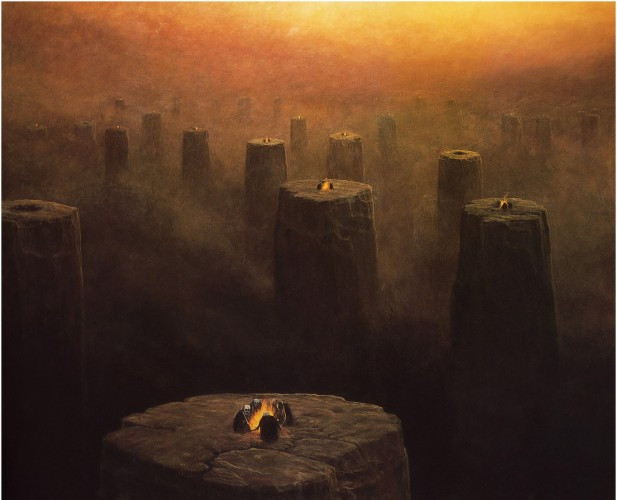
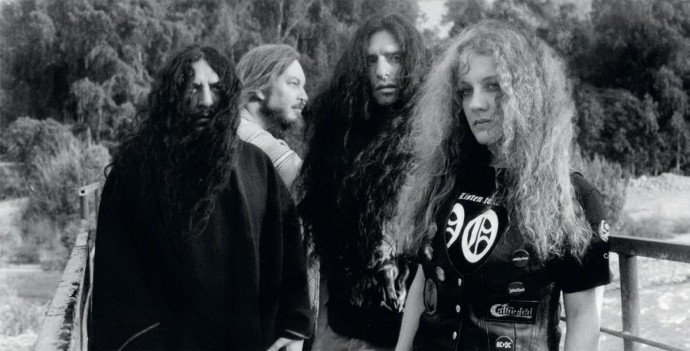
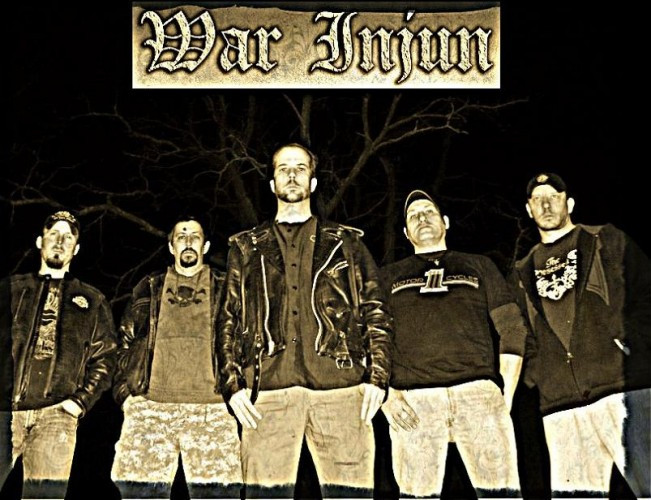
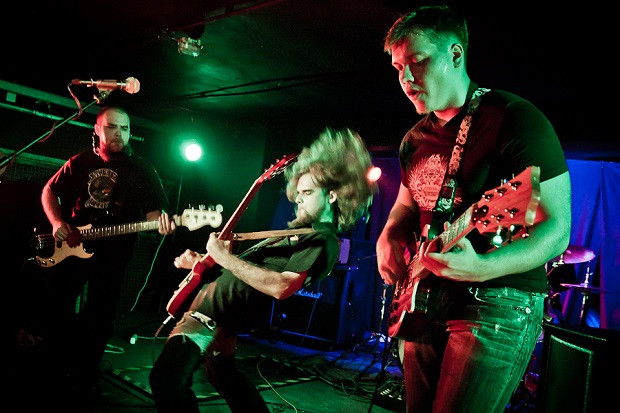
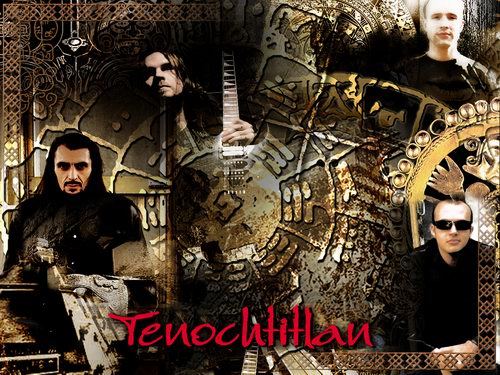
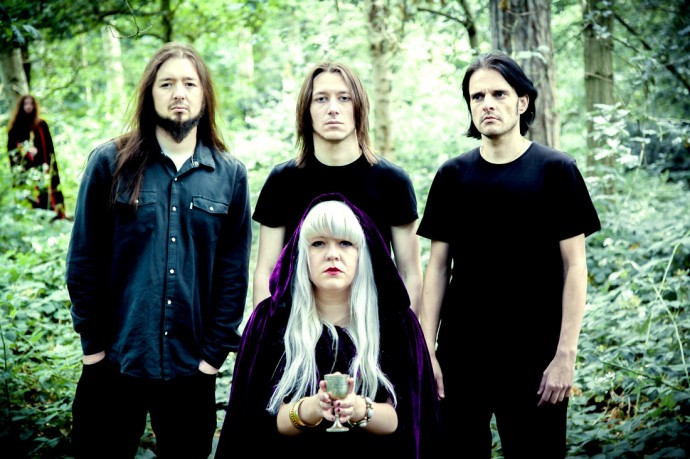
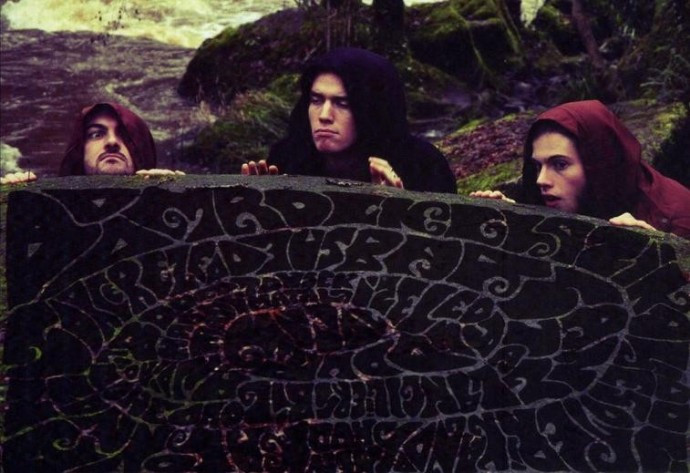
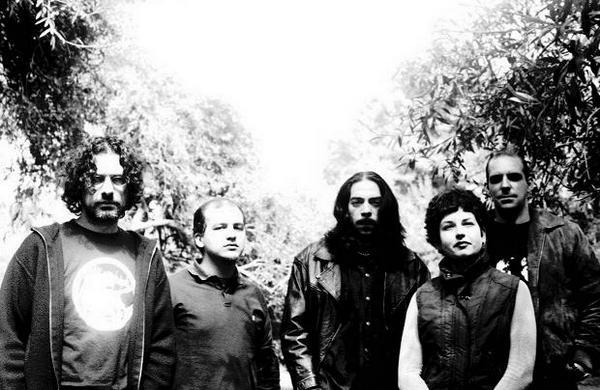
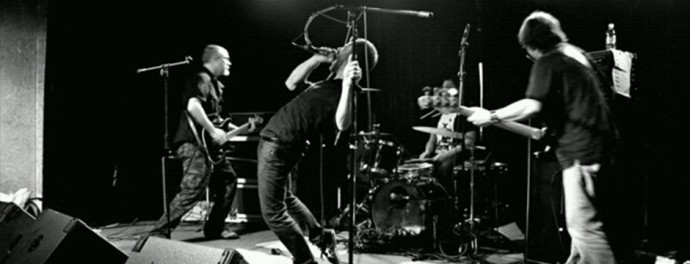
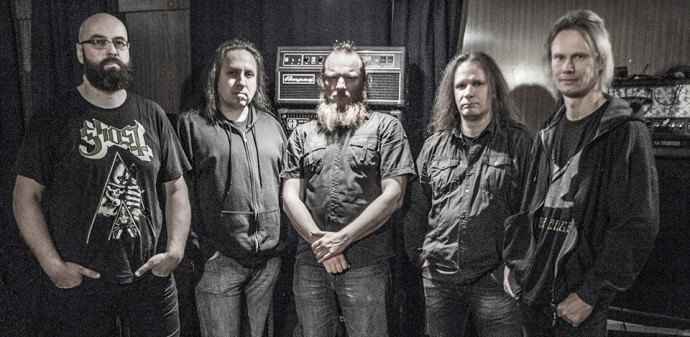
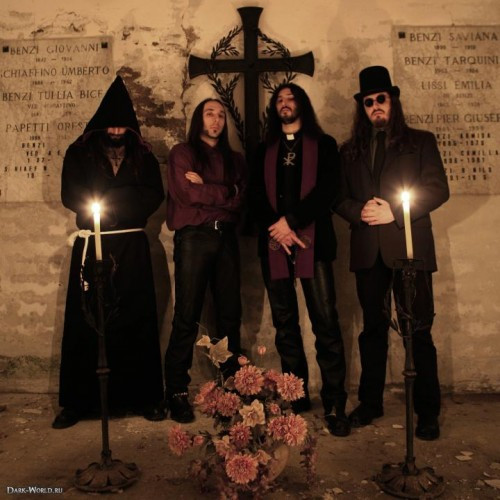
Yes sir, I do indeed know the band War Injun from Hagerstown, Md and they are indeed awesome
Having been to Tenochtitlan, I think the namesake band’s music would fit right in there. Weird, heavy… nice!
Was fortunate enough to witness Abysmal Grief’s funeral mass a couple weeks back while visiting Prague.
I’m envious!